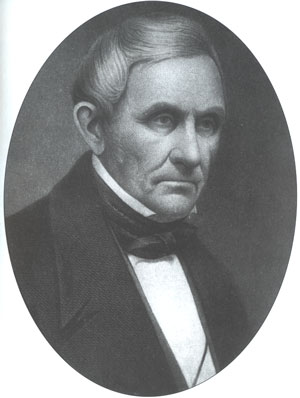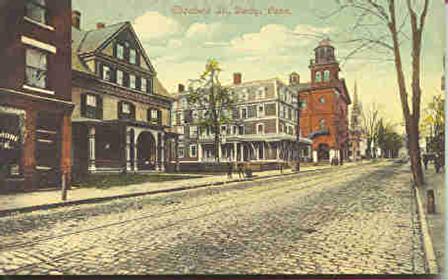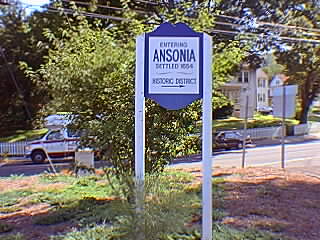How Ansonia came to be and Received its Name
From the book – History of Derby, Connecticut 1642-1880
Published in 1880 by Rev. Samuel Orcutt & Dr. Ambrose Beardsley
* Asterisks indicate insertions made by the Derby Historical Society

After Birmingham (*today’s downtown Derby) had become established, as far back as 1836, Anson G. Phelps conceived the idea of utilizing the waters of the Naugatuck for manufacturing purposes upon the west side of the river, and thus making one continuous village, and finally a city, from Birmingham north a distance of two or three miles, the location being eminently beautiful, and he continued in an unsettled state of mind six or eight years before making any purchases of land in view of carrying out his notable project. By this time he had come into possession, by various purchases, of all the desirable real estate on the west side of the river except one piece called the “Old Bassett farm”, and was so situated as to be the key of the whole enterprise.
Learning from busy rumor what was going on, Stephen Booth, (often called Squire Booth) stepped in to play a sharp game of speculation, and bought the farm for $5,000, a big price to pay in those times, for agricultural purposes. Whether this was done to defeat the grand object of Mr. Phelps or to extort money, it is not easily determined, but Mr. Phelps, chagrined at the movement, rested his labors and took matters coolly, as he was not easily cornered and held in “durance vile” by his strategy.
At length Peter Phelps, the agent of his uncle, Anson G., made advances to Mr. Booth….Ten thousand dollars was the sum talked of and partially agreed upon, but no writings were drawn. Meanwhile, Mr. Booth moved into the ancient house on this farm, and when the rising sun greeted the old mansion his speculative brain fancies golden visions of the future while he thus soliloquized: “This farm is the key to Phelps’ adventure, and to me these rocks are as diamonds of great value, and I will yet get my price”.
At the next meeting, the old farm had gone up in value to $15,000…Many stories, pro and con, were raised about town, and an influential committee from Birmingham – Sheldon Bassett, Donald Judson, and others, waited on Mr. Booth, and in vain tried to persuade him to sell his farm, and if he wanted it for cultivating purposes, as he claimed, another was offered worth twice as much, but this seemed no temptation.
The farm grew in value upon his mind, and after awhile, matters remaining in status quo, Mr. Booth became anxious, and hearing from one and another that he could get his $15,000, made advances to Peter Phelps, and an hour was appointed for an interview. The meeting was held in the parlor of Dr. Beardsley at Birmingham. After a lengthy preamble Mr. Booth said, “I have concluded to part with the farm, and after all that has been said the lowest price now cash down is $25,000, but if this offer is rejected the lowest figure hereafter will be $30,000”.
Peter Phelps, the agent who had full powers to close the bargain at $15,000, and expected to do so, spurned the proposition and turning indignantly said “Go to h__l with your old farm; and when you get back what we first offered let us know”. This was a back stroke to the wheel of fortune for Mr. Booth and a fatal blow to the city project of Birmingham

Mr. Phelps now turned his attention to the east side of the Naugatuck, but this was claimed by Old Booth (as he was now called) simply a ruse to overreach him, and once more the old farm was held in still higher valuation. The first survey of the grounds now teeming with the busy life of Ansonia was made by John Clouse, Anson G. Phelps, Almon Farrel, and other gentlemen. After nearly a day’s tramp around the lots, Clouse planted himself upon a high rock near where the Congregational church now stands (*on South Cliff Street), and casting his eyes around said “Mr. Phelps, this is one of the finest places for a village in this Western world. I would be content here to live and die, and to be buried near this very spot with no other monument to my name than this rock and the memory of those who may come after me”. Purchases were immediately made, and about the same time the Seymour dam, built by Raymond French, was bought, which defeated the purpose of a manufacturing village on the west side of the river a mile north of Ansonia to be called Kinneytown.
Mr. Phelps now bent his masterly energies toward carrying out his plans, and the last lingering hope of selling the diamond farm did not vanish from the mind of Mr. Booth until he saw, in 1845, a long line of Irishmen with picks and shovels, carts and horses, ready to commence broad and deep the canal and other foundations for the new village. From the first building erected on Main Street, Ansonia has steadily grown in wealth, population, and enterprise until she now vies with any manufacturing village in the State. Eagle-like, she has spread her wings in all directions, and the old Bassett farm, having undergone many mutations, is now adorned with beautiful lawns and gardens, and dotted with neat little cottages and elegant mansions. Many imprecations were heaped upon Mr. Booth by the people of Derby, for being a stumbling block in the way of Birmingham’s progress, while the denizens of Ansonia may now rise up and call him blessed.
While Mr. Phelps was one day at Dr. Beardsley’s dinner table, about this time, he said “Doctor, we are in such a quandary as to what to name our new village. Some are in favor of calling it Phelpsville, but I have one place by that name already”.
The Doctor remarked “I suppose you would like your name associated with the place”.
“That would be very desirable”, Mr. Phelps replied.
Impromptu, the Doctor said, “Take your Christian name, Anson, and make a Latin name of it and call it Ansonia; this will be euphonious, rather poetical, and will carry your name down to the latest generation”.
Instantly Mr. Phelps dropped his knife and fork and exclaimed. “That is the name; it suits me exactly”, and at the next meeting of the company it was adopted, and hence it was called Ansonia.

